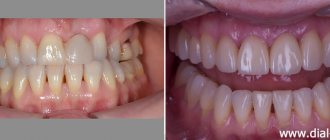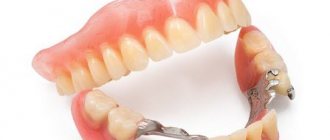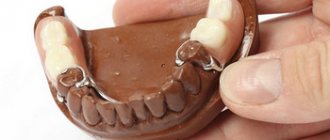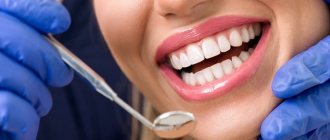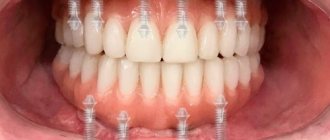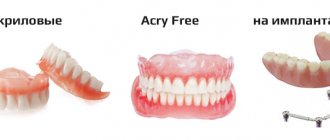Concept and signs of supernumerary teeth
Hyperdentia (hyperdentia from hyper and lat. dens, dentis tooth) is an anomaly in the number of teeth.
Up to a certain age, children should ideally have twenty milk teeth, which are gradually replaced by permanent ones, and there are 32 of them. With hyperdontia, these numbers shift by one or more positions in a larger direction, since in this case there are one or several more tooth buds than normal.
Supernumerary teeth, as a rule, erupt after the main teeth, but there are exceptions when the supernumerary has erupted and taken the place where a normal tooth should be. As a result, teeth shift and bite changes. Only in rare cases does hyperdontia make itself felt during the period of milk eruption. Most often, this anomaly occurs among men, which accounts for about 65% of the total number of such cases.
In 15% of cases of this anomalous phenomenon, more than two supernumerary teeth erupt on the gum or palate. The most common phenomenon among hyperdontic anomalies is the eruption of supernumerary teeth in the area of the lateral incisors on the upper jaw, and less often on the lower jaw. Such teeth may differ from normal ones in shape, structure, color, which indicates their abnormal origin.
In what cases is it necessary to remove supernumerary teeth?
Removal of supernumerary teeth is recommended in 90% of cases. You can refuse surgical intervention in the following cases:
Simply put, if a supernumerary tooth causes inconvenience, pain or discomfort, it is removed. |
Hyperdontia in an adult
In adults, hyperdontia is much more common than in children. Additional teeth are mainly located in the palate or on the gums, which is unnatural and contrary to the norm. The eruption of an “extra” tooth can cause the following symptoms:
- Impaired diction. The person begins to burr and vaguely pronounce some sounds and sound combinations.
- A feeling of discomfort caused by the abnormal position of supernumerary teeth. Such teeth provoke curvature of the dentition.
- Malocclusion. This problem entails a number of dental diseases, such as pathological tooth wear, impaired diction and others.
- Damage to the oral mucosa with subsequent inflammation;
- Impaired chewing function, which leads to gastrointestinal problems.
This type of anomaly often causes nervous breakdowns and mental disorders. Due to the displacement of the dentition, healthy teeth lose their strength and begin to loosen under the pressure of the growing supernumerary rudiment. The jawbone swells, which leads to pain. Constant aching pain leads to irritability, apathy and deterioration in general well-being.
How many primary and permanent teeth should a child and an adult have?
Healthy and strong teeth are the key to good health and maintaining a decent quality of life. They are involved in the digestion process and are also needed during conversation for the correct reproduction of sounds. From childhood, many people remember that a healthy adult should have 32 teeth in the oral cavity, but in the milk “set” there are only 20 such elements. Should there really be 32 healthy teeth? Could there be more or less dental elements, and if so, why? What anomalies of dental development occur? The answers to all these questions will be found in this article.
Timing and order of eruption of baby teeth
Newborns usually have no teeth in their mouths. In rare cases, a baby is born with 1-2 milk teeth at once. Traditionally, it is believed that a baby’s first tooth should erupt at the age of 6–7 months.
Modern dentists say that the average period for the appearance of teeth has now changed slightly; in most children, teeth erupt only at 7.5 - 8 months, but it happens that a child acquires an incisor already at the age of four months. It is considered normal if the tooth erupts before the child reaches 1 year of age. The milk bite is fully formed by 2.5 – 3 years. The timing and order of eruption presented in the table are approximate. A delay in eruption in time up to six months is a variant of the norm, as is the appearance of teeth in the “wrong” order at first glance.
| Child's age, months. | Jaw | Name of a pair of teeth |
| 6 — 10 | Lower | Central incisors |
| 8 — 12 | Upper | |
| 9 — 13 | Upper | Lateral incisors |
| 10 — 16 | Lower | |
| 13 — 19 | Upper | First molars |
| 14 — 18 | Lower | |
| 16 — 22 | Upper | Fangs |
| 17 — 23 | Lower | |
| 23 — 31 | Upper | Second molars |
| 25 — 33 | Lower |
Features of changing baby teeth to permanent ones
At the age of 4 - 5 years, the roots of temporary teeth begin to dissolve - this process is invisible to the naked eye, it lasts about 2 years. At 6–7 years old, the baby loses the first primary tooth. The order of loss corresponds to the eruption pattern. That is, if a child’s lower central incisors erupted first, they will be the first to fall out. The last temporary tooth falls out by the age of 13.
How long does the process of changing the bite take? It takes 6 – 8 years. The terms are also individual - deviations of up to 24 months are acceptable. In girls, the change in bite usually begins earlier than in boys.
How many permanent (molar) teeth should an adult have?
The standard answer to the question about the number of teeth a person has is 32. Each jaw should have 16 dental elements, which grow in pairs and have antagonists in the opposite row. The teeth of the upper and lower jaws have the same names, but their size and structure may vary slightly.
Central and lateral incisors
Each jaw has 4 incisors - a pair of central ones and the same number of lateral ones. The total number of incisors is 8. The central elements of the upper jaw are larger than the lateral ones, while in the lower jaw the opposite is true. The function is to bite off (“cut off”) pieces of food. Each incisor has a chisel shape and 1 rounded root.
Fangs
An adult, like a child, has 4 fangs - a pair of elements in each jaw. These elements are more similar than others to the teeth of a predatory animal. They are distinguished by a convex shape, a single tubercle and a sharp edge. The lower canines are narrower than the upper ones and, unlike the latter, are slightly tilted back.
Molars and premolars
Premolars and molars are designed for mechanical grinding and chewing of food. An adult has only 8 small molars (premolars) in the jaw. A pair of such teeth is located on each side of both jaws between the molars and canines. The first premolar is rounded, slightly slanted towards the tongue, with a flat, flattened root. The second premolar is larger in size, it has more developed tubercles, between which there is a horseshoe-shaped fissure.
The number of large molars in an adult is 12. They are divided into three subspecies. The first molars are distinguished by their large size (usually a “six” - the tooth with the most massive crown), a rectangular crown part with developed tubercles and a clearly visible fissure. Unlike canines, incisors and premolars, a large molar has two roots, one of which has 1 canal, and the other has 2.
Second and third molars are similar to first molars. They differ in the number and severity of tubercles, as well as the shape of the fissures. How many wisdom teeth? There are usually only 4. Third molars, known as wisdom teeth, can have irregular crowns as well as unpredictable roots that sometimes become crooked and even intertwined.
Reasons why teeth may be smaller or larger than normal
Knowing that the standard number of teeth is 32 (including third molars), after counting their own dental elements, some people wonder: “Why did I only grow 28 or only 30?” “Wise” teeth – third molars are usually cut between the ages of 18 and 25. Without them, there will be 28 teeth. These teeth have a “complex character.” Some people have 2 wisdom teeth out of four, and if they are antagonists, this is the norm. Sometimes they do not come out at all, but if this does not cause pain or discomfort to the patient, then it is also not considered an anomaly.
The number of people who lack even the rudiments of wisdom teeth is growing. For this reason, they have 28 teeth, which is normal. Sometimes there are more than normal. The 33rd element becomes an additional third molar, but sometimes an “extra” tooth grows in front. In the latter case, it is removed. A person can grow up to 36 teeth. This often happens during an unsuccessful multiple pregnancy, when one of the embryos dies and its tooth buds “go to” the surviving fetus.
What are the types of dental growth abnormalities?
The most common dental growth abnormalities include:
- Delayed eruption of permanent teeth. If your baby teeth have fallen out, but your permanent teeth have not erupted for a long time, this is a reason to see a dentist. This problem can be caused by a genetic predisposition. In some cases, this is due to the absence of molar rudiments. This is possible if they have not formed at all in the child or have been destroyed due to inflammation. In the last two cases, prosthetics will be needed.
- Two rows of teeth. This happens when “extra” teeth erupt, if the jaw is underdeveloped and there is simply not enough space for them. If the baby tooth does not fall out in a timely manner, the permanent one may grow in the second row, since there is no room for it in the main. This anomaly looks unattractive, but can be easily corrected. You need to contact a dental clinic, the doctor will identify the reason for the formation of an additional row and develop a strategy to solve the problem. This could be removing extra teeth (missing baby teeth), wearing braces, etc.
- Permanent teeth may grow crooked. This often happens, and it is better to correct the anomaly in childhood. It is much easier, faster, cheaper and more effective than at 25 or even 18 years old.
www.pro-zuby.ru
Hyperdontia in children
Sometimes the eruption of extra abnormal teeth in children is almost asymptomatic. The only sign of polyodontia is the number of teeth erupted, which exceeds a certain norm for a particular age. Most often, this anomaly is accompanied by a number of unpleasant symptoms, which should cause concern among parents and become a reason to consult a dentist.
Signs of polyodontia in children:
- a rapid increase in temperature, which is difficult to bring down and lasts from one to several days;
- a strong aching or throbbing pain is felt at the site where the irregular tooth erupts;
- there is a feeling of discomfort when talking, eating, drinking;
- a slight swelling of the cheek and even the wing of the nose is noticeable on the side where the extra element erupts;
- due to excessive salivation as a reaction to an irritating factor, a wet cough and difficulty breathing may occur;
- gastrointestinal disorder as another reaction of the body to the inflammatory process and high temperature.
The symptoms of the eruption of supernumerary teeth in children are similar to those observed when the first milk teeth appear, only in this case the situation is a little complicated by the fact that the germination of an extra tooth is not something normal and inherent in nature. This makes it more difficult for the child to tolerate this phenomenon than the eruption of healthy baby teeth.
A similar sign
Folk signs are a relic of the past, to which the modern skeptic listens. Changes in the body suggest future events for adults and children. If a wisdom tooth does not grow, breaks, crumbles or hurts, you won’t have to wait long for changes. People attribute problems with molar incisors to ancestral curses and sins that come from the family.
Content
Signs about wisdom teeth
Answers
Who has it broken?
In a woman
Women are more emotional; all their processes affect, first of all, their psychological health. Signs related to teeth are no exception.
Chip Tooth Meanings:
- The presence of holes in the aura and vulnerability to ill-wishers.
- A quick divorce. This is especially true for those who are married and experiencing problems in their relationship with their husband. It's time to take urgent action if you want to save the marriage.
- Betrayal of a loved one. Applies to women and girls of any age.
- Losing money. You need to be careful with purchases or transactions. And it’s better to always keep your wallet with you.
- An attack by an energy vampire, who may be a good friend or even a relative. It is worth taking a closer look at those around you.
In a man
Men are rational and do not give free rein to emotions. Their signs are more often associated with specific things - physical ailments, problems at work. If a fang or molar breaks off, this means:
- Serious long-term illness. It is advisable to go to the clinic and undergo an examination.
- Problems at work - demotion or dismissal, financial losses.
- Road accident, car breakdown. It is better to avoid traveling by personal transport.
Chipped tooth in children
For a child, a piece breaking off from a tooth portends a quarrel with a friend. Despite their young age, such conflicts can be very long-term and serious. Parents will have to intervene and help resolve the conflict without far-reaching consequences. It is better to switch the child’s attention to the appearance of the tooth fairy, who has prepared sweets for him.
There used to be a popular superstition about how a child behaves during a split. This was how they determined how he would grow up in the future. The more the baby cried and screamed, the more demanding and capricious he became. The one who endured this trouble silently and steadfastly became a strong personality, a real master of his own destiny.
Everyday superstitions
Normal jaw development ends with the growth of wisdom teeth, which occurs between the ages of 18 and 27 years. The sooner they get out, the sooner the young girl will get married, and the guy will find what he loves.
The sign promises the young lady a promising marriage with a wise man. If a wisdom tooth is cut on the eve of an important event, it is the key to success. Signs associated with the processes help resolve protracted conflicts - if the gums become inflamed before the trial, controversial issues can be resolved.
It is good if the wisdom tooth grows quickly and does not cause painful symptoms. This sign is favorable for a young couple who have been waiting for a long time to join the family. The dentition is replenished immediately 4 - the year will be prosperous and successful.
Causes of jaw abnormalities
To date, doctors have not reached a unanimous opinion about the causes of such an anomaly as hyperdontia. There are different hypotheses about this:
- Atavism. Historians have proven that primitive people, due to the way of life they led, naturally had 36 tooth primordia. The results of studies of the remains of those times indicate that people had six incisors on the upper and lower jaws. Therefore, polyodontia is a kind of genetic anomaly that makes itself felt after thousands of years;
- Many doctors are inclined to the theory that one embryo splits into several in the womb, when, in fact, they begin to form. This theory also states that an anomaly can develop throughout pregnancy if it was quite severe, the woman suffered serious illnesses or led an unhealthy lifestyle (bad habits, drugs, alcohol and others);
To date, research continues to establish the true cause of hyperdontia. Based on these data, modern doctors are more inclined to the second version than to the first.
Teeth - how many do children and adults have?
When asked how many teeth a person has, everyone answers 32. Everyone knows about this. This is what we were taught in school, and numerous advertisements in the media speak about this. But if you start counting them in your mouth, many adults will count fewer, which is surprising. So how many teeth does an adult have and what is considered normal?
Structure of permanent teeth
How many teeth does an adult have?
If a person, when counting, finds only 28, and not 32 teeth, then he immediately wonders where the other four went. Every dentist will explain this situation to you.
An adult has exactly 32 teeth. If there are fewer than 28 or 30, this means that the third molars have not yet grown. These are eights. Their development begins much later. All permanent teeth occupy the jaw rows from 6 to 12 years of age. At the age of 16, dentists consider a number of children to be formed. Although the third molars have not yet grown during this period, their rudiments are already there and they have taken their place. But for most people, they may never appear or appear only on the upper jaw. How they develop depends on a dozen circumstances:
- genetic predisposition;
- the influence of evolution on the development of the jaw system;
- food consumed and much more.
Genetics and dentists have noted that in the process of evolution, human teeth have also changed. Initially there were 44 of them. Our distant ancestors consumed solid foods. Therefore, their jaw system was different, and all teeth took part in chewing. Today, soft food predominates in the diet. The human lower jaw has become smaller and there is not enough space for the third molars to develop. This is the reason why they remain in their infancy and sometimes erupt incorrectly.
Eights begin to grow by the age of 17. This process is considered complete by 25. Therefore, if by this time a person does not see the required amount in his mouth, it is recommended to consult a dentist. It will exclude an anomaly in the development of third molars, when they grow to the side and displace the molar located nearby.
Therefore, if we answer the question posed above, there is no clear answer. A person has 32 teeth. But the numbers 28 and 30 are also considered normal, subject to normal development.
Location
This is a human bone organ that is incapable of regeneration. They play an important role in the digestion of food and are the first in the digestive system. The first ones, which appear from 6 months to 2 years, are milky. By the age of 10–12 years, they should be replaced by permanent teeth. Their number is 28. Nature is designed in such a way that a person’s teeth fall out once, and then they are replaced. Therefore, it is important to keep them healthy.
Can a person have 33 teeth? This anomaly is extremely rare. Scientists say that this is 3% of the entire population.
Number of dairy
The moment of the appearance of the first incisors is touching, even despite all the capriciousness of the child. All parents are looking forward to it. Milk teeth, like their successors, also have a root system, blood vessels and nerve endings. That's why some children suffer from pain. They are also susceptible to diseases and require normal care.
They are laid in the embryonic period, and begin to grow when the child is 6 months old. This is an approximate time. It is possible that the start of eruption may move in one direction or the other. This is considered the norm. They grow up to two and a half years. They appear in a certain order.
- If the child is from 7 to 9 months old, there are 4 of them. These are two upper and lower incisors.
- About 8 teeth should be present at 1 year. The readings are inaccurate, since for a certain percentage of children this figure reaches 12.
- From 1.5 to 2 years, their number varies from 18 to 20.
- A child aged 2 years has exactly 20 teeth.
The development of baby teeth is individual and depends on dozens of factors. Therefore, if they notice small deviations from established norms, this is not a reason for parents to panic and worry.
Dentists and pediatricians use a formula to determine the number of teeth: subtract four from the number of months of a child’s life. According to it, the number of teeth at 2 years is 20. These are 8 incisors and the same number of molars, 4 canines.
In the period from 2.5 years to 3 years, a period of freezing begins in the development of the child’s jaw system. All 20 teeth of a child are actively involved in chewing. During this period, it is important to follow the rules of hygiene and monitor their health.
The enamel of baby teeth is thin and is more susceptible to caries, so children are not immune from this disease. Don’t be afraid to contact the dentist if your baby’s row has become unusable. Modern equipment helps make the treatment painless for the child. The formation of permanent ones depends on their health. Therefore, it is important to keep an eye on them.
Number of indigenous
The four, five, six and eight in the upper and lower jaws on each side are called molars. There should be 8 primary molars, 4 on each row. An adult has 20 of them, 10 on each jaw, including the four third molars. But since they may not exist, the number of molars in the mouth of an adult varies from 16 to 20.
Dentists distinguish between small molars (premolars or fours and fives). The crown has 2 visible cusps. They have one or two roots. Their function is to grind food. The rest are large molars (first, second, third molar or six, seven and eight). There are 12 such teeth. The crown already has four visible tubercles. The number of roots reaches 4, and sometimes 5 pieces.
Humans have 8 primary primary teeth. The structure differs from permanent ones, but they perform the same function as their successors. If you want your child to have no problems for a long time after the jaw is fully formed, teach him the procedure for oral hygiene, enrich his diet not only with foods rich in calcium, but also with vitamins and minerals. Teach and explain that you need to visit the dentist regularly.
zubychist.ru
Types of hyperdontia
Depending on the location of the supernumerary teeth, several types of polyodontia are distinguished:
- Conical or awl-shaped tooth . In this case, excess rudiments erupt between the upper central and lateral incisors. The name of the anomaly comes from the peculiar shape of the supernumerary tooth, which looks like an awl. This form of hyperdontia is dangerous because the sharp end of the tooth often injures the mucous membrane, which is why an inflammatory process develops when an infection gets there.
- Additional molars . Such teeth grow between the main molars, displacing the dentition from the correct position.
- Extra fangs . This type of anomaly is typical for the upper jaw.
- Supernumerary premolars . These additional teeth are located on the lower jaw. Each type of anomaly looks different depending on where and how the extra teeth are located. These differences can be clearly seen in the photo.
What does the dental formula look like in a medical record?
The dental formula of an adult, as well as a child, in the medical record of a dental patient looks in the form of a schematic table (Fig. 5), which will reflect only the serial numbers of permanent or baby teeth.
Directly in this formula, the doctor will mark the missing teeth (in this case, the number is crossed out with a cross), which teeth are affected by caries, pulpitis or periodontitis, as well as which of them have crowns or bridges. Dental formula in the form of a table in the medical record –
Diagnostic methods
Diagnosis of polyodontia is carried out exclusively by a specialized doctor - an orthodontist, who conducts a preliminary examination of the oral cavity and dentition, refers the patient to x-rays (orthopantomography) and analysis of anthropometric casts of teeth made of plaster. Such models are made for a more detailed study of a specific anomalous phenomenon, on the basis of which a diagnosis is then made and treatment is prescribed.
Table of normal human teeth. Deviation from the norm - polyodontia
When examining plaster models made on the basis of dental casts, the doctor measures the size of the teeth, and then analyzes the data obtained based on a special table by Wetzel and Ustimenko. The length of each row of teeth must be measured. This indicator may fluctuate depending on such characteristic individual characteristics of a person as crowding of teeth or the presence of large gaps between them. In the first case, the length will be less than normal, and in the second, a little longer. To diagnose asymmetry, the distance from the midline of the palate (or hyoid frenulum) to the far point of the dentition in one direction or the other is determined.
What to do?
The presence of supernumerary teeth is an abnormal phenomenon, so the issue of eliminating this problem must be resolved. How, this is another question, to give an unambiguous answer to which is impossible. As a rule, there can be several ways to solve a problem. The choice of treatment method depends on where the extra tooth is located, what shape it is, and what stage of eruption it is at.
Facilitating teething in baby
Drug treatment allows you to relieve unpleasant and painful symptoms during the eruption of excess buds. This option is the only one for children with baby teeth if the tooth is only at the eruption stage. When it finally germinates, it will be necessary to use more radical methods. The dentist prescribes medications that will help relieve pain, reduce fever and stop the inflammatory process in the soft tissues of the gums.
Simple tooth extraction
Surgery. This method is the fastest and most effective, since removing an extra tooth easily solves the problem and relieves a person from unpleasant sensations and discomfort. This treatment method is used when there is too little space in the dentition for an extra tooth or there is no space at all. Most often, supernumerary teeth are removed when there is crowding of the teeth. To free up some space in the dentition, the wisdom teeth are removed first, and if this was not enough, the premolars are also removed.
Braces and other orthodontic treatment methods
Orthodontic treatment is a method that involves correcting the bite, straightening the teeth, etc. The result is achieved by installing braces or other orthodontic structures that allow you to straighten crooked teeth and return them to their place, where they should be. The duration of wearing braces depends on many factors:
- the age of the patient (children have their own specifics);
- complexity of the situation;
- locations of supernumerary teeth and others.
At the first and second stages of the disease, the doctor may decide to install special expansion plates or aligners. Can also apply the separation method.
Consequences of poor quality treatment
If the treatment is not well-carried out, impacted teeth will continue to interfere with the normal development of the bite and dentition, which causes a violation of chewing ability, leading to a number of problems with the gastrointestinal tract, and impaired diction, which negatively affects pronunciation and pronunciation. Also, after unsuccessful treatment, healthy teeth that are located next to the additional one may begin to deteriorate.
Preventive measures
The essence of preventing dental anomalies is to eliminate the possible causes of their appearance even at the stage of formation of rudiments, that is, all responsibility for possible dental anomalies depends entirely on the child’s mother.
To prevent this unpleasant phenomenon, you need to eat right, food should be balanced and healthy. It is important to give up bad habits and follow your doctor’s recommendations. When the baby is small, you need to make sure that he does not suck his finger or pacifier for more than a year and regularly take him for examinations to the dentist for timely detection and elimination of dental problems. Moscow metro station Zvezdnaya, Danube Avenue, 23
News
This site uses cookies. The terms of use of cookies can be read here.
The site also uses the Internet service to collect technical data regarding visitors in order to carry out analytical work related to improving the quality of service, informing users about changes on the site and notifying users of responses received in correspondence and on the forum by sending messages to the specified e-mail.
The site can record IP addresses
The terms and conditions for processing site visitor data can be read here.
By using the site, you confirm your agreement with the above rules. If you do not agree with the rules, you should immediately stop using the site.
Cookies
When you access the Site, some information in the form of “cookies” or similar files may be automatically downloaded to your computer. This allows us to customize the site according to your interests and preferences. If you do not want cookies to be sent to or stored on your system, most Internet browsers will allow you to delete cookies from your computer's hard drive, prevent them from being stored, or signal you before a cookie is stored. To learn more about these features, you should refer to your browser instructions or help information.
IP address
The site may record IP addresses (Internet protocol addresses) of visitors in order to collect and analyze statistical data on site traffic for subsequent improvement of the services provided. It should be noted that the IP address does not contain any personal information and does not refer to personal data.
Consent to the processing of personal data
Hereby, in accordance with Federal Law No. 152-FZ “On Personal Data” dated July 27, 2006, I freely, of my own free will and in my own interest, express my unconditional consent to the processing of my personal data, registered in accordance with the legislation of the Russian Federation.
Personal data is any information relating to a directly identified or identifiable individual.
- I have given this Consent to the processing of the following personal data:
- First Name Last Name
- Date of Birth
- Residence address
- Email address mail
- Telephone
- Photo
- Personal data is not publicly available.
- Consent is given to the Operator to perform the following actions with my personal data using automation tools and/or without the use of such tools: collection, systematization, accumulation, storage, clarification (updating, changing), use, as well as carrying out any other actions provided for by current legislation RF.
- This Consent is given to the Operator for the processing of my personal data for the following purposes:
- Sending notifications to me regarding the services provided
- Preparing and sending responses to my requests
- Sending me information, including advertising, about events, changes in the Operator’s services.
- The operator has the right to entrust the processing of personal data to another person with the consent of the subject of personal data, unless otherwise provided by federal law, on the basis of an agreement concluded with this person, including a state or municipal contract, or by adoption of a relevant act by a state or municipal body (hereinafter referred to as the assignment operator). The person processing personal data on behalf of the operator is obliged to comply with the principles and rules for processing personal data provided for by this Federal Law. The operator’s instructions must define a list of actions (operations) with personal data that will be performed by the person processing personal data and the purposes of processing, the obligation of such a person must be established to maintain the confidentiality of personal data and ensure the security of personal data during their processing, as well as the requirements for the protection of processed personal data must be specified in accordance with Article 19 of this Federal Law.
- This Consent is valid until its withdrawal by sending a written notification to the email address
- If I withdraw my Consent to the processing of personal data, the Operator has the right to continue processing personal data without my consent if there are grounds specified in paragraphs 2-11 of part 1 of article 6, part 2 of article 10 and part 2 of article 11 of Federal Law No. 152-FZ “On personal data” dated June 27, 2006.
- This Consent is valid all the time until the termination of the processing of personal data specified in clause 6, clause 7 of this Consent


